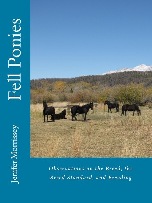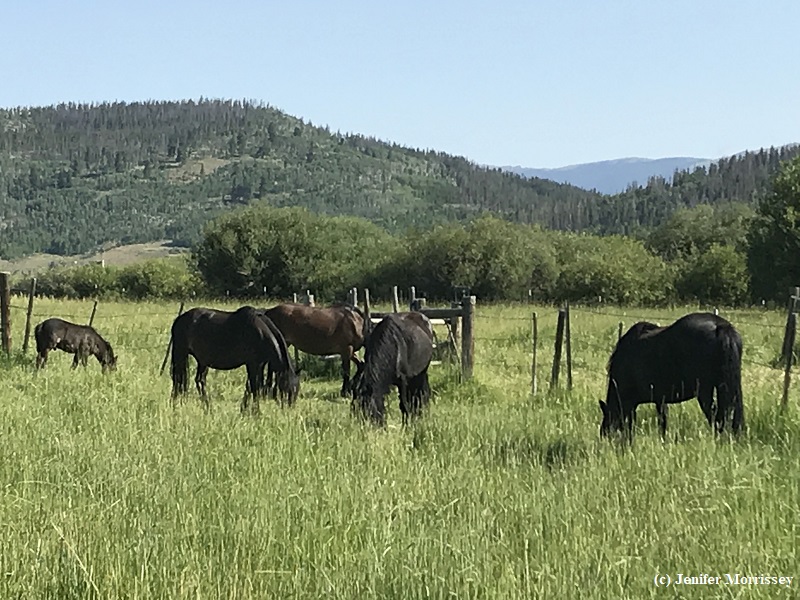This article originally appeared in the September 2016 issue of Fell Pony News from Willowtrail Farm.
Most if not all the Fell Ponies doing conservation grazing at this time are doing it for their owners or close associates. Some other mountain and moorland pony breeds, though, are being used for conservation grazing where cash may change hands and where an organization is a middleman between a breeder or breed association and a land owner. I have been curious how those businesses have been set up to be successful.
Conservation grazing is the use of grazing animals to manipulate landscapes towards certain conservation goals. Sometimes there are also incentives for using rare breeds of livestock.
Much work must be done before conservation-grazing animals hit the ground of course. The Thorpe family’s project with the Wellbrow Fell Ponies took a full twelve months of planning. What the grazing animals choose to eat and how they impact the landscape must be known in advance to ensure that a particular conservation grazing project meets its objectives. The Fell Pony is fortunate to have a passionate researcher, David Anthony Murray, researching and documenting Fell Pony grazing patterns to inform conservation grazing projects, including the one at Wellbrow.
There are opportunities for other conservation grazing projects for Fells, but one of the difficulties for the Fell Pony Society as the breed’s registered organization is that “Land is owned and managed by so many different organisations and private landowners that there is no single easy place or person to inform [that] you would like to be involved.” (1) In addition, “there are several grazing tasks out there but they need suitable ponies and flexible owners. Some tasks are only for a few weeks, and might only need two ponies while others are much larger and may be over a longer period of time.” (2)
Two other native pony breeds are benefiting from taking conservation grazing to the next level: from individuals involving their own ponies to a service that is a one-stop-shop for conservation grazing. It is evident from reviewing materials from the Dartmoor Pony Heritage Trust and the Sussex Pony Grazing & Conservation Trust (which uses Exmoor ponies) that there is much more to running a conservation grazing service than just performing the ecological job. The logistics of sourcing ‘suitable ponies’ and dealing with varying durations are examples of the ‘more’ that’s involved.
Sometimes education is needed before ponies can be considered for conservation grazing. In their 2015 Prospectus, the Sussex Pony Grazing and Conservation Trust makes the case for native breeds of ponies as conservation grazers:
Many of the important wildlife habitats that exist in Britain today have been created through centuries of human management, often associated with grazing by livestock. The effect of these activities is to consistently halt the natural plant ‘succession’, that is, the progression from lower plants through to the ‘climax’ vegetation’, usually woodland. This creates what is called a ‘plagio-climatic’ or ‘semi-natural’ habitat, meaning a human-influenced habitat… Over time, many species have evolved interdependently with these environments and therefore cessation of grazing and resultant habitat loss threatens their continued survival. (3)
Because native ponies have been part of shaping the environment and therefore the species that live there, they can also be appropriate choices for helping maintain the environment on which those species depend.
Here are common characteristics for the two native pony conservation grazing organizations, each of which has been underway for nearly a decade or more.
Regarding the pony part of the service, providing ponies for grazing doesn’t mean just having a herd to loan. For instance:
The organizations have to plan each project not only with the conservation goals of the project in mind but also the ponies. Where will they get water, for instance? Will they be able to reach all the areas that need their attention? Are facilities in place to enable handling of the ponies when necessary?
Many conservation grazing locations are open to the public, so the ponies must have a suitable attitude towards people – wary enough to stand off and not be threatening to un-horse-savvy visitors but not so wary as to be afraid and unable to do the job they’re meant to do.
Some projects are of limited duration and precise timing, so ponies must be delivered and then picked up on a particular schedule.
The organizations retain responsibility for the ponies’ welfare – hooves, worming, general health, etc. Often the ponies are checked by volunteers who may need training on equine stewardship, training which is usually developed and delivered in-house.
As the Fell Pony Society Conservation Grazing sub-committee pointed out in their article cited above, there are opportunities for conservation grazing out there but there is not a single place to go to find out about the opportunities. Perhaps an enterprising Fell Pony enthusiast can create something similar to what has been created for the Dartmoor and Exmoor ponies, a not-for-profit focal point for Fell Pony conservation grazing. The interest is obviously there from both the pony and the landowner side.
Walker, Eileen A. “Conservation Grazing,” The Fell Pony Society Magazine, Spring 2016 Volume 32, p. 66.
Same as #1
Prospectus 2015. The Sussex Pony Grazing & Conservation Trust, http://sussexponygrazing.co.uk, p. 4/13
With thanks to Fell Pony enthusiasts Eddie McDonough and Judith Bean for providing pointers to Exmoor and Dartmoor pony conservation grazing projects.




































